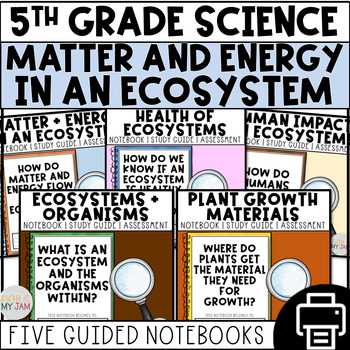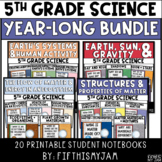Energy and Matter in an Ecosystem | Printable Notebook ONLY Bundle
- Zip
- Google Apps™

Products in this Bundle (6)
showing 1-5 of 6 products
Bonus
Also included in
- ➡ PLEASE READ BEFORE PURCHASING ⬅By purchasing the bundle, you receive all units/notebook sets within this bundle at a 30% discount. As additional resources are added, the bundle's price will increase accordingly. By purchasing the bundle at the current price, you will receive future resources addedPrice $89.99Original Price $170.95Save $80.96
Description
What does an ecosystem include, what is an aquatic biome and a terrestrial biome, and how do human activities affect ecosystems? While the standards closely align with 5th Grade NGSS standards, if you are teaching about ecosystems and organisms in general, this may be perfect for you! Here your students will learn more by answering the following Big Questions:
- What Is An Ecosystem and the Organisms Within?
- Where Do Plants Get the Material They Need For Growth?
- How Do Matter and Energy Flow In An Ecosystem?
- How Do We Know If An Ecosystem is Healthy or Unhealthy?
- How Do Humans Change Ecosystems?
❤ This product is included in a YEAR LONG BUNDLE marked down 30% off with digital components included.
➡ NEED MORE THAN JUST A PRINTABLE NOTEBOOK?
➡ NEED A DIGITAL SET ONLY (no printable included)?
Click here to get this product and four other lessons completely digital.
❤ Click here to get the FREE Energy and Matter Within an Ecosystem Unit Assessment.
Included in this bundle:
- FIVE lessons of full guided student notes with reading passages included for the flow of energy and matter in an ecosystem, the organisms within, what makes an ecosystem healthy and unhealthy, and how humans change the ecosystem. (Only one version of notes for each lesson (page number + lesson number) included)
- Six investigations for a hands-on and presentation experience.
- Supporting study guides.
- 10 question assessments.
- Outlined Scope and Sequence for each lesson.
- Start Here Guide with suggested tips + tricks for where to start.
➡ NEED A DIGITAL SET FOR EACH LESSON?
All Flow of Energy and Matter DIGITAL notebooks, assessments, and study guides are included in this set ONLY, not with the individual lessons! Use these digital products while experiencing distance learning or if your students are 1:1. (with partially-graded assessments in Google Forms, all short answer questions and constructed responses need to be manually graded - unless you make that change after copying).
**PLEASE email me (fifthismyjam@gmail.com) if you have any questions or need support.
Next Generation Science Standards Addressed:
5-PS1-1
5-PS3-1
5-LS1-1
5-LS2-1
5-ESS3-1
You can find other companion products here:
Word Wall Vocabulary Cards | Life Science
Animal Research Packet Animal Magazine Project
Types of Organisms | No Prep Digital Learning | Distance Learning
Don't forget that leaving feedback earns you points toward FREE TPT purchases. I love that feedback!
Also, FOLLOW ME and be notified when new products are uploaded. New products are always 50% off for the first 48 hours they are posted. It pays to follow me!
Additionally, SUBSCRIBE to my email list to get biweekly freebies and tips and tricks for the upper elementary classroom!
Please feel free to contact me with any questions!
Thank you kindly,
Rachel Jamison






